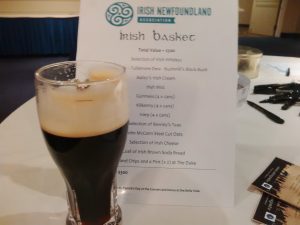ARCHIVAL MOMENT
March 18
In Newfoundland and Labrador there has been a long established tradition to refer to the day following St. Patrick’s Day as Sheelagh’s Day.
As early as 1819, the Anglican Missionary and historian Lewis Anspach who wrote the first general history of Newfoundland wrote:
“It is hardly in the power of any priest in the world to hinder an Irishman from getting gloriously drunk, if he is so inclined, on the whole of the 17th of March, as well as the next day in honour of Sheelagh….”
The St. John’s newspaper, The Newfoundlander on reporting on the celebrations of the members of Benevolent Irish Society in St. John’s on March 17, 1829 wrote:
“The company continued to retire, successively, until six o’clock on Sheelagh’s morning, (March 18) at which hour, we understand, a few of the campaigners might have been seen, as usual, piously and patriotically employed in “drowning the shamrock.”
Other than Ireland and Newfoundland only Australia is known to have celebrated Sheelagh’s Day. There is evidence that it was celebrated in Newfoundland as early as 1819 with reference in Australia first appearing in the 1830s .
As with St Patrick’s Day, Shelah’s Day was associated with celebratory drinking.
 The first mention of Sheelagh’s Day in Australia occurs in a 1832 newspaper report of a woman who was charged with a number of minor offences, and who pleaded in her defence that her behaviour could be blamed on the fact that it was Sheelagh’s Day. The Sydney Gazette, on March 24, 1832 reported that Martha Grayburn was brought before the courts and argued in her defense that she was under the influence on ‘ Sheelagh’s Day’ . The newspaper reported:
The first mention of Sheelagh’s Day in Australia occurs in a 1832 newspaper report of a woman who was charged with a number of minor offences, and who pleaded in her defence that her behaviour could be blamed on the fact that it was Sheelagh’s Day. The Sydney Gazette, on March 24, 1832 reported that Martha Grayburn was brought before the courts and argued in her defense that she was under the influence on ‘ Sheelagh’s Day’ . The newspaper reported:
“Shelah’s Day.—Martha Grayburn, ‘a would if I could, but I can’t’ sort of a lady, was brought up for the commission of divers peccadilloes on the evening of Sunday. Martha pleaded ‘Shelah’s Day’ in extenuation, and was ordered to ‘go and sin no more’.”
As in Newfoundland the clear indication is that Sheelagh’s Day is an occasion for the continuation of the festivities of St Patrick’s Day, no doubt including the consumption of alcohol.
The Australian newspaper , the Brisbane Telegraph reported on March 16, 1876:
” It is in small towns, villages, or hamlets, in the bush, on the outside of civilisation, where drunkenness reigns on St. Patrick’s day, and worse on Shelah’s day.”
Shelagh (also Shelah, Sheila, Sheilah, Sheelah) in Irish folk legend is somewhat of a mystery she is variously described as the wife, sister, housekeeper or acquaintance of St Patrick, patron saint of Ireland.
In Newfoundland few refer to March 18 by her name day; nowadays her name is only invoked with reference to any storm that takes place on or shortly after March 18 – the storm being referred to as Sheelagh’s Brush.
So ingrained in the Newfoundland psyche is the association of with Sheelagh and the last storm of the winter season is that the fishing fleets were reluctant to put out their gear and the sealing fleets were reluctant to take to the ice preferring to wait until after Sheelah’s Brush had passed.
Sheila’s Brush typically brings a heavy snowfall. The snow is attributed to Sheila’s sweeping away of the last of winter. But, once the brush blows through – it signals that Spring is just around the corner.
Pity her name is not invoked as it was in our past. It is time to reclaim March 18 to give this day, the traditional name, Sheelagh’s Day.
Sláinte!
Archival Collection: At the Rooms Provincial Archives take some time to look at MG 612 the BIS collection it consists of minutes of the BIS (1822-1933, 1938-1970, 1973-1979); agendas (1964-1970); Centenary Volume (1806-1906); loan receipts (1905-1906); journal (1910-1920); cash book (1920-1931); ledger (1939-1944).
Museum Exhibit: take some time to see: Talamh an Éisc – The Fishing Ground , an exhibition at The Rooms, that introduces the Irish peoples who have been in Newfoundland and Labrador since the late 1600s, the exhibit explores the communities they built and celebrates the contributions they made to life here in Newfoundland and Labrador.
Recommended Reading: Freitag, Barbara. 2004. Sheela-na-gigs: Unravelling an Enigma. London: Routledge, 2004, pp. 62-67.



